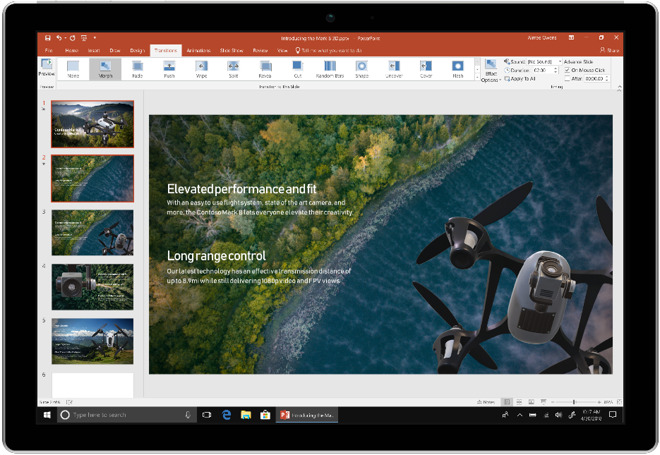2020-4-5 How to get Microsoft Office for iPad and iPhone. The Microsoft Office apps are free to download from the App Store (Word, Excel, PowerPoint. What's new in Outlook for Mac. The new Outlook has many new features and improved experiences, including: Customizable toolbar. Choose commands to display in the Toolbar. In the Toolbar, select the more icon, then Customize Toolbar. Improved search. Search is now powered by Microsoft Search and has better results and suggestions. Mar 17, 2016 Office for Mac 2011 is 1.31 GB while some of the main Office 2016 apps are individually larger than that. Word is 1.66 GB, Excel is 1.47 GB, Powerpoint is 1.32 GB, and Outlook is 1.03.
When done artfully, the effect of moving an object along a path in PowerPoint 2011 for Mac can add drama, change the mood, and draw attention to selected objects on your slide. You can select an object and then have it follow a path that is represented by a line in Normal view, but the line is invisible while the presentation is playing. You can draw your own lines or choose from a wide selection of built-in lines and effect options.

Inserting a shape
Any kind of object can follow a path. Here’s how to choose a shape:

Open a new, blank presentation in PowerPoint.
Click the Ribbon’s Home tab, and in the Slides group, choose Layout→Blank.
A completely blank work area is now available.
Click the Ribbon’s Insert tab, and in the Shape group, click Rectangles.
Choose any Rectangle on the submenu.
Drag the mouse on the slide area to make a small rectangle.
Your rectangle shape is now ready to be animated.
Applying a basic or complex motion path
As with other animations, the general procedure for applying a motion path is quite simple:
Select an object.
Click the Ribbon’s Animations tab, and in the Motion group, click Paths.
The Motion Paths gallery displays.
Choose a Basic or Complex motion path.
The following things happen as you apply a path:
a.A line representing the path that will be followed displays.
b.Your shape follows the path to give you an instant preview.
c.The Motion Paths icon and the Effect Options icon on the Ribbon change to match the icon of the path type chosen.
d.A number is displayed that shows the path animation’s number within the animation sequence.
e.A green arrow indicates the starting point of the path and a red arrow with a bar indicates the endpoint.
Right-click the line to edit points. Right-click a point to display point options in a pop-up menu. Drag the blue selection handles to resize the path line. Drag the path line or the shape to reposition the path line.

Applying a custom path
The steps to apply a custom path are the same as the previous heading except for Step 3:
Select an object.
Click the Ribbon’s Animations tab, and in the Motion group, click Paths.
Choose a line tool from Custom section of the palette.
Choosing path effect options
Each kind of path comes with its own set of effect options. To see the options, select the path and then click the Effect Options button in the Animation Options group on the Animations tab of the Ribbon. The Effect Options button’s icon changes, depending upon what type of motion path is selected.
Customize the document headers and footers in Word 2011 for Mac to show page numbers, dates, and logos for formal stationery. You can work with headers and footers in several of Word 2011’s views. The quick way to work with headers and footers is by way of the Header and Footer group on the Office 2011 Ribbon’s Document Elements tab.
Clicking either the Header or Footer button displays a gallery from which you can choose a style for your header or footer. The basic layout of three positions (left, center, and right) is the first style on the palette. Notice that some styles affect only odd-numbered or even-numbered pages. Some of the styles apply tables to the header or footer, so if you click into one of these styles, the Format Tables tab on the Ribbon will activate.
When you choose a header or footer style, Word changes the interface so that you can type in your header or footer. You can display this view by choosing View→Header and Footerwithout having to choose a style from the Ribbon. To work with the interface, simply click into it and type. Click the Page # button on the Ribbon to display the Page Numbers dialog, which you can use to choose alignment and formatting options for your page numbers.
To exit Header and Footer view, choose a view from the views listed in the topmost group of the View menu, or double-click the document body. You can also click the small Close button below the Header or above the Footer area.
How Big Is Earth
You may want to format your Header or Footer to display Page # of #. To make this custom format starting without a Header or Footer style, do the following:
Microsoft Office For Mac Torrent
Choose View→Header and Footer from the menu bar.
Click within either the Header or Footer area.
Your cursor will be at the left. Press Tab once or twice to move to the center or right, if desired.
Type the word “Page,” followed by a space.
Choose Insert→Field from the menu bar.
Make sure that Categories is set to (All). Under Field names, choose Page and then click OK.
Add a space and then type of followed by another space.
Choose Insert→Field from the menu bar.
Under Field Names, choose NumPages and then click OK.